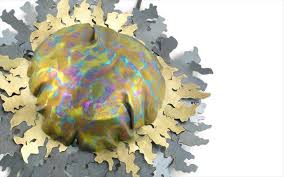Simona Peneva
Journeys, landscapes and underwater sculptures inspire Danae Natsis to experiment, thus "giving birth" to her unique jewellery. The artist who is of Greek-Australian origin presents her exhibition called "Wreckage adrift", hoping that one day her works will tell the generations stories of our modern era.
How did you come up with the idea for these creations?
The works started as automatic drawings, random lines on paper, drawing without thinking. I am interested in accidents, and randomness and the way they are used in the creative process and in art. The concepts from the series evolved over a period of experimentation. I began playing with metals and materials, shaping, hammering and colouring the creations. The forms that originated from these experiments started to look like aquatic creatures, shipwrecked and ancient artefacts and landscapes - islands and mountains. I related these shapes to my own personal journeys.

What countries did you visit during your journeys? Which one was the most inspiring for your creations?
The journey that I undertook immediately after the Shipwreck series took me to Munich, Amsterdam, Paris, London, the USA, and Greece. In all of those places, I spent countless hours in museums and galleries. I went on road trips and I drove through landscapes that I had never seen before, including deserts, canyons, deep forests, and through places that were more familiar; islands and mountains. While the pieces directly refer to Greece and my Greek heritage, all the historical artefacts, artworks, the landscapes that I saw and the objects that I found and collected, influenced the pieces I have made, consciously and subconsciously. They refer to journeys and maps, both literally and conceptually.
What inspired you for this collection?
I love history and learning about past times from the objects that they have left behind. When I make objects, I wonder if they will survive long after I am gone. Will they be what people in the future will see from my time?
In particular, there was an exhibition at the National Archaeological Museum in Athens about the Antikythera Shipwreck. The layers of encrustation that had built up on the artefacts that had been submerged for thousands of years created a new kind of beauty. The course of time and an accident that happened 2000 years ago have allowed these shapes and forms to exist. There were marble sculptures that had been half buried, on the floor of the ocean. The side that had been exposed to the water was eroded and pockmarked, like a coral, but the side that had been buried in the sand was still smooth and perfect, like it was when it was carved.
What is the purpose of this exhibition? What would you like to express?
With these works I wanted to make pieces that were playful and unrestrained. I wanted to make large, colourful and uncontrolled works. I wanted to make jewellery and wearable pieces that were the opposite of minimal.
 What makes your collection so unique in comparison to other pieces of jewellery?
What makes your collection so unique in comparison to other pieces of jewellery?
I am flattered if people find my work unique, but that is a difficult question for me to answer.
How did you create these pieces? Was it difficult? Was it spontaneously or was it a result of long-term efforts and work?
There was a tremendous amount of time and work that went into this series. Each piece took many hours to complete. The pieces were made using a variety of techniques, using specialised equipment and materials. I experimented with my techniques, perfecting them over the course of one year before the exhibition. Getting things right, making them how I want them to be can be difficult and involves a lot of tests. I stayed at a place called Montsalvat in Australia where I just carried out experiments over the course of two months, every day. I work with niobium, a reactive metal, which can be anodised when using electric current. This means that the metal changes colour when different voltages pass through it. I apply colour to metals like silver, copper and shibuichi using pigments and patination. Patination is a process of oxidising metal using various chemicals to produce different colours and effects.
Will the exhibition be shown only in Greece?
The exhibition has already been shown in Sydney, Australia and some of the pieces have been exhibited in other Australian cities. The pieces are about to be shown in Barcelona at the Joya Barcelona Contemporary Jewellery Fair
What are your plans for the future? Do you have any new ideas?
I have many ideas all the time. Most recently, I have been painting. I have been experimenting with collage and mixing my own paints with pigments, mediums, binders, textures and powders. I always want to try everything, to learn new techniques and use new materials.